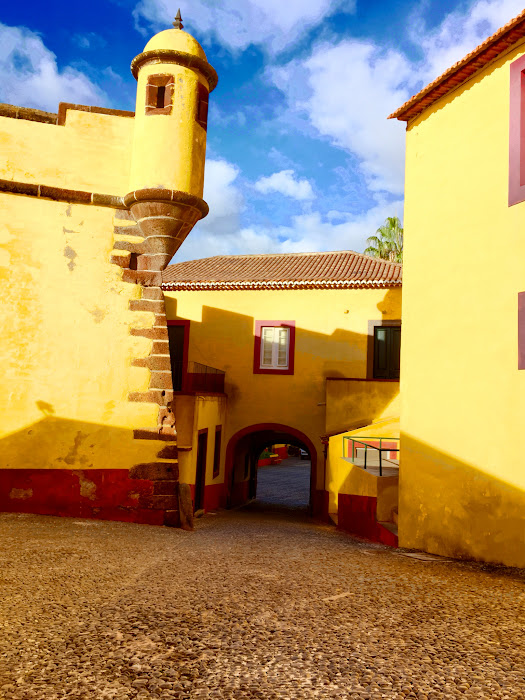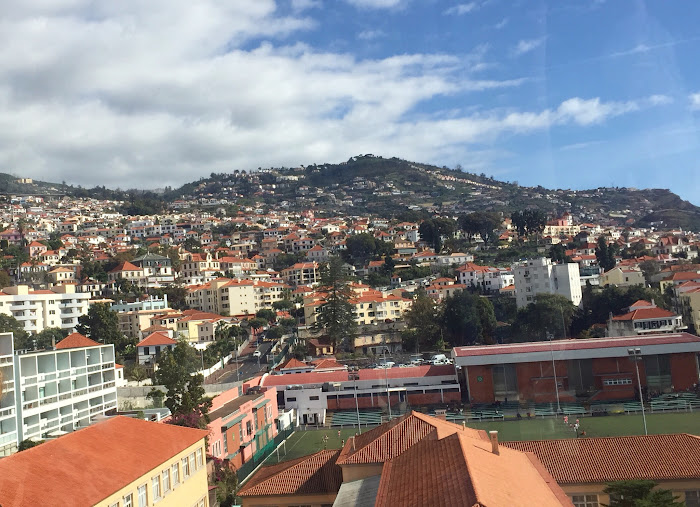







Thoughts mostly about travel and places I have been. While a lot of my travel is into the backcountry backpacking or paddling I do my share of trips to more traditional front-country locations too. From time to time other items of note will appear that definitely fall outside the realm of travel and associated things. It is also worth noting that I am legally blind.

































(Apologies for any typos).
We are settling down to our second night in Funchal, Medeira. Our first day and large-portion of another have gone by rather well l. M. In fact, we think this is the best start in many ways to any of our more recent trips. Yesterday we spent a few hours strolling the environs near the hotel, avoiding the worst of the downpours that came mid-afternoon, and wrapping things up with a very enjoyable meal at a nearby restaurant called Arsenio's (listen to a sample of the live music by clicking on the Play button in the music player at the start of this post. I am not sure if what we heard would be called fado [from Wikipedia: <a href ="https://en.wikipedia.org/wiki/Fado">Fado</a>] but I hope it was).
 |
| Fort St. James |
 |
| Funchal is riddled with narrow twisting streets. At least on one street in the Santa Maria region numerous buildings have these wonderful door murals. |
Today has been a productive long day. We slept in until sunrise, about 8:10 ( it is amusing that getting used to the nearly hour later sunrise compared to Rhode Island due to the location of Madeira within its timezone is something to contend with) we ventured down to the large buffet breakfast before beginning our rambles around at least a modest portion of Funchal. We were eager to explore and the iffy weather of the day before had been left behind and we were greeted with clear blue skies and lovely warm sunshine. The predicted high would be in the mid-60s F (18C) and it certainly felt that warm especially when the sun beat down directly upon us. Lovely. We visited St. James (I think) Fort not far from the hotel and found it basically closed. Their is supposed to be a bit of an art museum thre but it seemed closed. The pastel yellow buildings are nice enough and the view from the wall of the sea is good but you won't really get much out of the exploration of the fort because their isn't much to explore. Still by visiting the fort we then had a chance to venture through narrow streets that sported numerous doors with intriguing artworks. I don't know if the door murals , sometimes painted and sometimes three-dimension art, are special to just this area or something more generally done in Madeira. Now that I think about it I do not recall really noticing such art in other locations. Some is fanciful, some suggestive (the mermaid with a mail slot in her belly button comes to mind), and all was well done. Little touches like this bring a place to life.
We explored a bit farther west than we had the previous day finding some interesting markets along the way as well as a few city gardens that were pleasant enough to walk through. Obviously, we only saw a minuscule part of the city but what we found we liked and that certainly included portions that saw less tourist traffic than others did.
 |
| Two views from our steadily ascending cable car cabin as we rose into the clouds to visit the Palace Tropical Gardens. |
Working our way to the cablecsr, and being hailed by barkers trying to sell uscable car tickets or invite us into their entries, we boarded a gondola car to ride the 3,300 meter cable , ascending a bit more than 500 meters, to the Monte where the Palace Tropical Gardens (I think this is the correct name) are located. It is also the place where the Funchal toboggan run starts but more on that later. The cablecar ride takes about 15 minutes and you glide above countless red-tile roofed buildings and homes that grow less frequent as you gradually ascend. Now and then you can spot a goat tethered to a patch of grass, hear dogs bark in the distance, maybe a rooster cry. You are clearly rising about the outskirts of the capitol but I don't think we ever passed over anything like farmland or even a small vineyard. Maybe the homes with goats have gardens where they're growing edible plants but if so I bet it is just for themselves. When we disembarked the temperature was noticeably cooler and the light overcast blocked the sun. I believe cloud coverage like this is not uncommon in the mountains above Funchal. It was perfect walking weather. We paid our 10 euros apiece (cash only) to enter the gardens and spent the next 90 minutes or so working our way down the cobbled paths past plants too numerous to possibly name. I think the fern trees are the most impressive. I am quite certain that their are many paths you can take to get to various locations so return visits certainly could be worthwhile. Their is plenty to see and I suspect we just scratched the surface. It is a lovely setting.
The toboggans of Funchal were something we had seen video of and Dad and I were looking forward to giving them a go. It may be a bit tourist-trap-like but I think it was worth the 30 euros we paid. You settle into a wooden toboggan and two fit men clad in dark jackets, white pants and dark shoes, shove you off and hop of the back of the sleigh. The runners are, I am sure, greased, and you slide quickly and smoothly down the moderately steep road. Now and then the toboggan is caused to swerve from side to side, rotating its whole body left or right, to make a turn. You get rather close to walls at times and that could make a rider feel uncertain of the safety of the ride as you zoom down the hill at about 20kph along the 2km length of the journey. At one point the drivers hop off the toboggan, grab their tow ropes, and pull you along a flatter stretch of road. I wonder how they deal with oncoming traffic. We never saw any cars on that stretch of road and perhaps they're not permitted there. The road, in fact many of the roads I'd wager, is just one lane wide so if it is meant to support two-way traffic drivers must have to negotiate with each other who gets to go when. Dad and I were at our endpoint in about 6 minutes and had another 20 to wait for Mom to catch up with us. She didn't want to ride th toboggan and so walked the 2km and watched a couple other sleds zoom past as she descended not quite 300 meters to rejoin us. We then walked down the single-lane road (a bit of traffic coming past us from behind at seemingly great speed) down towards the coast. It's another 3km or so and you have to descend again just a bit under 300m before reaching the coast. You will feel it in your legs as the road is steep and near the end while you can get off the road and onto sidewalks the sidewalks treat you to numerous cobblestone steps. But it isn't a bad walk even though it is hardly the most picturesque.
By this time it was mid-afternoon and we had time to enjoy a short relaxing time back at the hotel, soak in the pool, soak under the sun on our patios, and then a second decent dinner out (no live music) at another nearby restaurant.
Our last day is proving to be a relaxing one. We rose at sunrise once again having felt that we did not sleep as well as we ought to have even though that has clearly proven to be a false belief. The day has been rather windy and until mid-afternoon it was more cloudy than not. However, when the wind isn't blowing the sun warms us quite nicely. We did a little more exploring venturing west along the coastal "Boardwalk" to where it seems to end in the Santa Catalina area. That area seems to have some rather large and nice apartments buildings, offices, small groceries, and other necessaries of city life. Along the way we would pass by just a couple modestly vast cruise ships (nowhere near as mammoth as the vessel we saw the day before) and some wonderfully purple coated stone walls. The purple are masses and masses of bugs villa (sp) plants. It is a good walk and the return through the city streets brings you by more gardens that are often well cared for. The only sad drawback now and then is the occasional homeless person you see and some are clearly in pretty dire straights.
After some 5 miles of walking about we have decided to call it an early day. It is possible we are short-changing Funchal but we have a sense that the bulk of what is interesting snuggles fairly close to the shore. Once you move a few blocks inland you are in residential areas that won't have much to offer the wandering tourist. Their are tourist=trap areas and tourist areas though aplenty to explore and we have enjoyed our two and a half days here even if today (Sunday) we have done only 3-4 hours of walking.